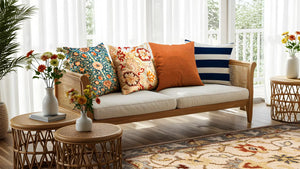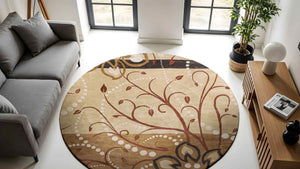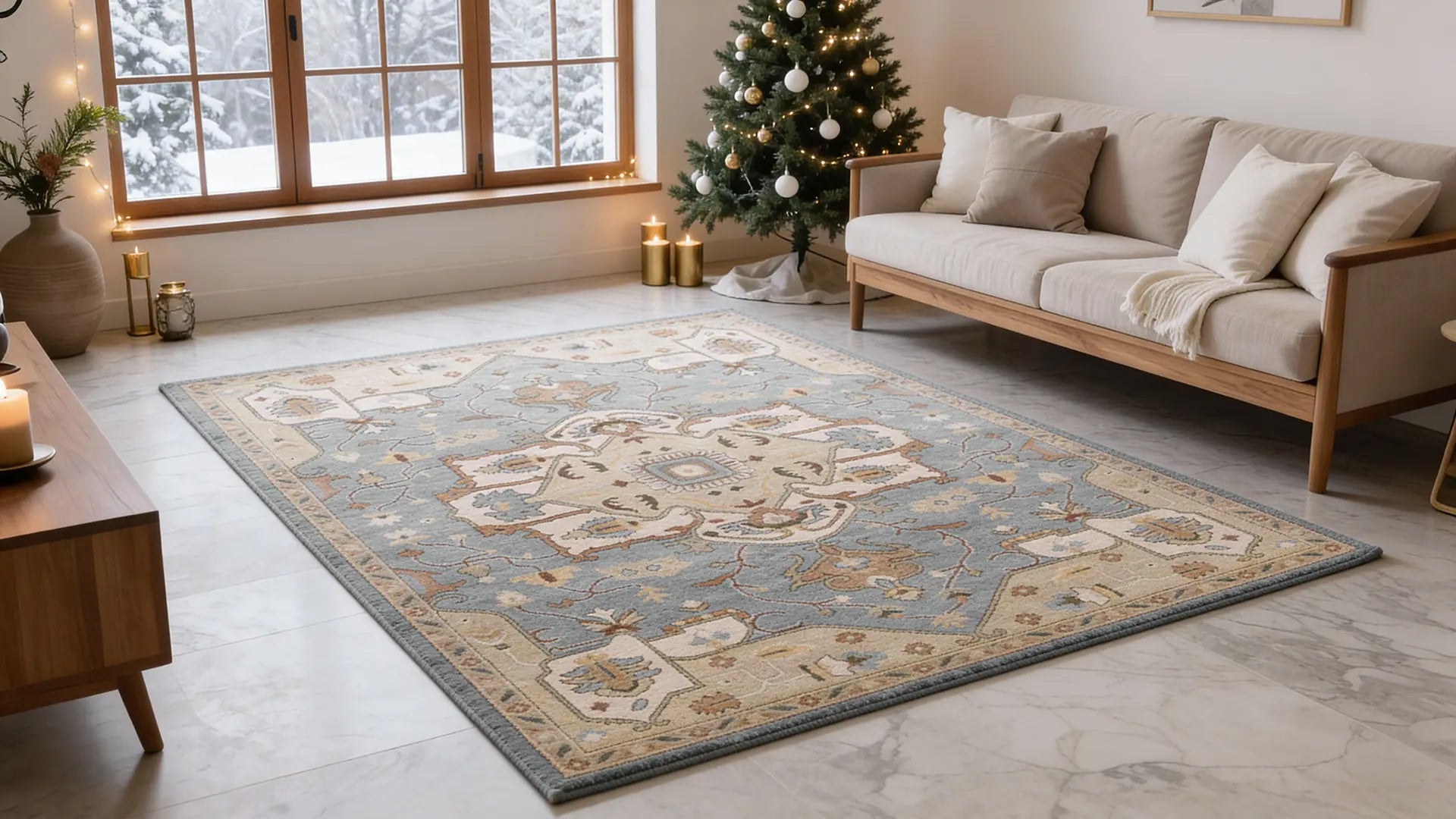Genius Ways to Position an Area Rug
When it comes to bedroom design, nothing quite pulls the space together like a well-placed area rug. More than just an accent, it sets the tone, defines zones, and enhances comfort. A strategically positioned area rug creates a visual anchor and adds warmth, especially in spaces with hard flooring such as hardwood, laminate, or tile. Think of it as the silent hero of bedroom décor—subtle, but powerful.
Interior designers often treat rugs as essential as furniture. Why? Because even the most luxurious bed frame can appear adrift in a sea of wood if there’s nothing grounding it. The rug does just that—it connects all the pieces, giving the room a cohesive and harmonious look. Whether it’s a minimalist studio or a spacious master suite, proper rug placement has the ability to transform your bedroom from “meh” to magazine-worthy.
Moreover, rug placement also affects how light moves through the room. For example, a light-toned rug near a window can reflect natural light, making your space feel airier and more expansive. In contrast, a darker rug underfoot can add depth and richness, making the room feel cozier.
Benefits of Using an Area Rug in a Bedroom
Aside from aesthetics, area rugs offer several functional benefits that make them a smart addition to any bedroom. For starters, they provide thermal insulation. Stepping onto a cold floor on a winter morning is no one’s idea of a good time—area rugs solve this instantly.
Sound absorption is another major perk. Bedrooms are meant to be sanctuaries, and rugs help dampen ambient noises. If you live in an apartment or a multi-story home, a rug can minimize the echo and soften footsteps, making the environment more peaceful.
Area rugs also offer a layer of protection for your flooring. High-traffic areas, especially those around the bed, are susceptible to scratches and wear. Placing a rug in these spots prolongs the life of your hardwood or laminate, saving you money in the long run.
Lastly, area rugs create an opportunity for self-expression. Available in a wide array of styles, colors, and textures, they allow you to experiment with your design without committing to permanent changes.
Choosing the Right Size Rug for a Bedroom
This is where many homeowners falter. Choosing the right rug size can make or break the design. The golden rule? Your rug should extend at least 18 to 24 inches beyond the sides of the bed. Anything less tends to look skimpy.
For a king-sized bed, you’ll typically want a rug that measures around 9x12 feet. This allows enough fabric to show on all sides, even with nightstands and benches in place. Queen-sized beds pair well with 8x10 foot rugs, while full and twin beds do fine with 5x8 feet or runners on either side.
When in doubt, go larger. A slightly oversized rug can still look stylish and expansive, whereas one that’s too small often feels like an afterthought. Remember, your goal is to frame the bed, not to leave it floating awkwardly in the room.
Understanding Bedroom Layouts Before Placing Rugs
Before unrolling that plush Persian rug, take a moment to understand your bedroom’s layout. Is the bed centered between two walls? Do you have nightstands or a bench at the foot? These details determine how your rug will look once in place.
Start by sketching a floor plan. Mark where your furniture sits and identify high-traffic zones. This will help you decide whether a full-room rug, a bed-framing rug, or a series of runners works best.
Also, think about visual weight. If your room has bold artwork or a dramatic headboard, your rug should balance—not compete with—those elements. Consider neutral colors or simple patterns in such cases.
Positioning an Area Rug Under a Queen Bed
A queen bed is the most common size in many homes, and it offers a lot of flexibility for rug placement. Ideally, you want the rug to start a few inches below the nightstands and extend past the foot of the bed. This frames the sleeping area beautifully without crowding your furniture.
There are three main options here:
-
Rug under the bottom two-thirds of the bed
-
Rug under the entire bed and nightstands
-
Separate runners on each side of the bed
Each option has its charm. The key is symmetry. Ensure that the rug extends evenly on both sides for a clean, balanced look. Bonus points if your rug color complements your bedding or wall paint!
Area Rug Positioning Tips for King Size Beds
With king beds, scale becomes essential. Because they take up more space, a rug must be large enough to accommodate the bed and still peek out along the sides. A 9x12 or 10x14 rug usually does the trick.
Place the rug so that it extends a good two feet from the foot of the bed. This creates a soft landing zone when you get up in the morning. If your room allows, go the extra mile and place the entire bed and nightstands on the rug. It’s luxurious, cohesive, and makes the bedroom feel extra plush.
Keep furniture balance in mind. A small rug under a large king bed will look disproportionate and may throw off the visual harmony of the room.
How to Place a Rug Under a Full or Twin Bed
When working with full or twin beds, especially in small bedrooms, rug placement requires a little creativity. These beds offer limited space, so you want to maximize comfort and aesthetics without crowding the floor.
For a twin bed, a 5x8 rug placed underneath or slightly off-centered works beautifully. You can also opt for a runner on one side or both sides if the bed is against a wall. This setup is practical and stylish, adding symmetry and warmth underfoot.
A full bed allows a bit more room to play. Here, you can use a 6x9 or 8x10 rug, ideally tucked under the bottom two-thirds of the bed. Make sure about 24 inches of rug extend beyond the foot and sides—this gives the illusion of more space.
When you’re decorating a shared kids’ room or guest room, you might use two separate rugs under each bed or one large area rug that runs beneath both. Just ensure there’s balance and that rugs don’t curl or shift. Rug pads can help with this.
Should You Put a Rug Under the Nightstands?
This is a commonly debated topic in interior circles. Should your rug extend beneath your nightstands? The answer depends on the size of your rug and your design goals.
If you’re using a large enough rug (like a 9x12 for queen or king beds), go ahead and place it under the nightstands. This approach creates a seamless, grounded look and enhances symmetry.
However, if your rug is smaller or you're opting for a three-quarter placement (rug starts beneath the lower two-thirds of the bed), then keep the nightstands off the rug. Ensure that there’s a clean break so it doesn’t appear unintentional.
In both cases, be wary of uneven legs—some furniture can wobble if partially on and off the rug. This is both a functional and aesthetic no-no. You can always use rug pads or felt furniture pads to even things out.
Rug Placement Around the Bed Perimeter
Not all bedroom layouts or rug sizes call for the classic under-the-bed placement. Sometimes, placing rugs around the bed perimeter offers more flexibility and a distinct visual flair.
Runners on both sides of the bed, or even at the foot, are perfect for smaller rooms or for showcasing hardwood floors. This configuration adds comfort where it matters most—where your feet touch the ground first thing in the morning.
This approach also works well in rooms where you can’t afford to place a large rug under the bed, due to HVAC vents, unusual furniture placement, or limited budget. In such scenarios, layering smaller rugs around the room's perimeter allows for texture and warmth without overcrowding.
Using Multiple Rugs in a Large Bedroom
Have a large bedroom or a master suite with multiple functional zones? Then using multiple rugs can be a savvy design move.
You might use one large rug under the bed and another under a seating area, reading nook, or vanity. This helps define separate areas within the same room. Just make sure the rugs complement each other—cohesive color palettes and complementary patterns go a long way.
Don't be afraid to mix textures. A faux fur rug under the bed and a woven jute rug by the sitting area can create contrast while still maintaining harmony. The key is visual flow—each rug should feel like it belongs in the same narrative.
Round Rugs in Bedrooms – Yay or Nay?
Round rugs? Absolutely, yay!
These circular beauties can add softness and a whimsical feel to a bedroom, especially when used under a round table, in a reading nook, or even partially tucked under the bed. They’re particularly effective in rooms with sharp corners or boxy furniture, offering a visual break and introducing organic shapes.
When placing a round rug, pay close attention to furniture alignment. If it’s going under a bed, only let it extend from the foot of the bed rather than trying to center it. That keeps the look intentional, not awkward.
Round rugs also work wonderfully in nurseries and children’s bedrooms, where they offer a playful and functional aesthetic. Try to pair them with other round or soft-edged decor for a cohesive feel.
What About Bedroom Rugs on Carpeted Floors?
Rugs on carpets? Absolutely. This might seem counterintuitive, but layering rugs over wall-to-wall carpeting is a proven designer hack.
Rugs on carpet add dimension, define zones, and introduce color or texture that might be missing from the plain carpet beneath. Just be sure the rug has enough contrast in texture or pattern to stand out—otherwise, it could disappear visually.
Use a rug pad designed for carpet to prevent bunching or sliding. This also adds an extra layer of softness and makes vacuuming easier.
Pro tip: If your carpet has a high pile, avoid thick rugs, which can wobble. Instead, go for flat-weave, low-pile, or tightly woven rugs that lay flat.
The Impact of Rug Patterns and Colors on Bedroom Design
Rugs aren’t just functional—they're an expressive element of interior design. A bold rug can become the focal point of your bedroom, while a neutral one can quietly support the overall theme.
Want to make a small room feel bigger? Choose light-colored rugs with subtle patterns. Need more drama? Go for deep hues and intricate designs. And if your room already has plenty of patterns (in bedding, curtains, or wallpaper), balance it out with a solid or tonal rug.
A rug's pattern can also define the room’s mood:
-
Geometric patterns feel modern and structured.
-
Floral or organic motifs bring softness and femininity.
-
Vintage oriental rugs add timeless charm and layered elegance.
In terms of color, match or contrast based on what’s missing. If your room is mostly neutral, a colorful rug becomes your canvas. If your decor is bold, a simple rug grounds the look.
Avoiding Common Area Rug Placement Mistakes
Even the most beautifully decorated bedroom can lose its charm if the area rug is placed incorrectly. Let's shed light on the most common mistakes and how to sidestep them.
Going too small is the #1 faux pas. A rug that barely peeks out from under the bed can make the space feel fragmented rather than unified. If the budget is tight, opt for rug runners instead of settling for a too-small rug.
Uneven placement is another common error. Your rug should be centered beneath the bed, not offset unless that asymmetry is part of a deliberate design. Always measure from multiple points to ensure symmetry.
Avoid placing rugs where they become trip hazards. If the corners curl up or the rug slips when you walk, use a non-slip rug pad underneath. Safety and aesthetics must go hand in hand.
Lastly, avoid clashing styles. A traditional Persian rug may not complement an ultra-modern bedroom unless done with intention. If you're unsure, start with neutral colors and simple patterns—they’re much harder to mess up.
Rug Placement for Shared or Children’s Bedrooms
Shared bedrooms require thoughtful rug placement to offer both comfort and individual expression. Whether it's siblings sharing a space or a room that doubles as a guest room, the rug strategy must enhance functionality.
Consider placing individual rugs under each bed if the beds are separated. This gives a sense of personal space while maintaining harmony. Alternatively, use one large rug to ground the entire room—ideal when beds are close together or bunked.
For children’s rooms, prioritize durable, easy-to-clean rugs. Bright colors and whimsical patterns work well here, but so do flat-weave rugs that are easier to vacuum and maintain. Safety is paramount, so avoid fluffy or high-pile rugs that can trap toys or become slipping hazards.
Using Rugs to Anchor Furniture in the Bedroom
Rugs are essential tools for anchoring furniture and defining zones within your bedroom. When placed correctly, a rug creates visual balance and gives each piece of furniture a "home."
Place a rug under your bed to anchor the sleeping zone. If you have a reading nook, place a round or small rectangular rug under the chair and side table to set that space apart. A rug under a vanity table or bench also frames those elements effectively.
Make sure that at least the front legs of furniture pieces are on the rug. This ensures they feel grounded and visually connected. Floating furniture can make a room feel disjointed, so anchoring with rugs helps create unity.
Creating Illusion of Space with Area Rugs
Yes, rugs can create the illusion of a larger space. This is particularly useful in small bedrooms or studio apartments.
A large rug that stretches beyond the edges of the bed makes the room feel expansive. Use light colors like ivory, beige, or soft gray to reflect light and open up the room visually. Stripes and geometric patterns can also elongate the space, depending on their orientation.
In narrow bedrooms, place the rug lengthwise to visually stretch the space. In wider rooms, center the rug under the bed and extend it outwards to fill the room.
Budget-Friendly Rug Positioning Ideas
You don’t need to break the bank to make a big design impact. There are plenty of budget-friendly ideas for rug placement that are high on style and low on cost.
-
Use smaller rugs creatively: Instead of one large rug, use two or three smaller ones placed symmetrically.
-
Shop off-season: Many retailers offer discounts at the end of summer or winter.
-
Layer rugs: Place a smaller, patterned rug over a larger, inexpensive jute rug for a designer look.
-
Repurpose existing rugs: Have an old living room rug? Move it to the bedroom and pair it with modern decor.
Rug placement isn't about price tags—it’s about proportions, purpose, and visual flow.
Area Rug Placement in Studio Bedrooms
Studio apartments call for smart zoning, and rugs are the ultimate tool for defining areas without walls. Use a rug to separate the sleeping zone from the living or working area.
A rug under the bed can signal a restful area, while a contrasting rug under a dining table or desk can define those functions. Opt for flatweave or low-pile rugs that are easy to maintain and don’t overpower the space.
Stick to a cohesive color palette to keep the studio visually unified. If you're layering rugs, ensure there’s a common design thread—be it texture, tone, or pattern.
Feng Shui Tips for Bedroom Rug Placement
In Feng Shui, rug placement influences the energy flow—or chi—of a room. Proper placement can enhance harmony, balance, and even improve sleep.
Place rugs so that they don't obstruct pathways. The energy should flow smoothly around the bed and furniture. Avoid rugs with chaotic patterns, as they may disrupt tranquility.
Rugs should extend equally on both sides of the bed to promote balance in relationships. Choose natural materials like wool or cotton for better energy absorption.
A round rug under the bed or in the center of the room symbolizes unity and continuity. It softens energy and balances square or angular room layouts.
The Role of Texture in Bedroom Rug Placement
Texture is often overlooked, yet it’s one of the most important factors in creating a cozy bedroom atmosphere.
A plush rug adds luxury and comfort underfoot, perfect for colder climates or romantic vibes. Flatweave rugs, on the other hand, are minimalist, easy to clean, and ideal for high-traffic zones.
Mixing textures? Yes, please. A high-pile rug under the bed and a sleek flatweave runner by the vanity creates a dynamic space. Just ensure the textures complement, not compete.
Maintenance Considerations Based on Rug Placement
Your rug’s location impacts how much dirt and wear it will see. Rugs at the foot of the bed or in entryways need more frequent vacuuming. Under-bed rugs should be easy to move for cleaning underneath.
Avoid placing high-pile rugs where you frequently roll office chairs or suitcases. For these zones, go for low-pile or indoor/outdoor rugs that are durable and stain-resistant.
Consider machine-washable rugs for kids’ rooms and rug protectors in high-traffic areas. Maintenance is much easier when you start with the right material in the right place.
Rug Pads: Are They Necessary?
You might be wondering—do I really need a rug pad? The answer is a resounding yes, especially in a bedroom where comfort, safety, and durability matter most.
Rug pads prevent slipping, a common issue that not only poses a safety risk but can also damage your flooring. They also add an extra layer of cushioning, which can make even a budget rug feel luxurious underfoot.
Beyond comfort, rug pads help extend the life of your rug. They absorb impact from foot traffic, protect the rug's backing, and allow air to circulate underneath—this helps prevent moisture buildup, especially on hardwood or tile floors.
Choose a non-slip, breathable rug pad tailored to your flooring type. For carpeted bedrooms, use a rug pad designed specifically for carpet-on-carpet layering to avoid bunching.
Using Rugs as Statement Pieces in the Bedroom
Sometimes, the rug is the main attraction.
A statement rug can set the entire tone for your bedroom. Think bold patterns, vivid colors, or artisan designs that draw the eye and spark conversation. In neutral spaces, a striking rug can inject personality without the need for bold wall colors or elaborate furniture.
Place a statement rug under the bed, ensuring it’s centered and fully visible. Pair it with simple linens and muted accessories to avoid overwhelming the space.
Alternatively, use a dramatic round or irregular-shaped rug in a reading corner or beneath a chandelier. This creates a mini focal point that’s both stylish and inviting.
Seasonal Bedroom Rug Placement Adjustments
Did you know you can update your rug layout seasonally?
In colder months, swap in a thicker, warmer rug like wool or shag to keep your toes cozy. These work well under beds and in high-traffic areas where warmth is needed most.
During warmer seasons, opt for lighter materials like cotton or jute. You can even scale down to smaller rugs or runners to let your flooring breathe and lighten the visual weight of the room.
Seasonal changes are a great time to rotate rugs to prevent uneven wear and sun fading. Plus, it’s a perfect excuse to refresh your bedroom style without a complete makeover.
Pet-Friendly Area Rug Placements
If you have pets, rug placement becomes more than a design decision—it’s a practical one.
Keep rugs away from pet food stations or litter boxes. Choose placement spots where your pets love to nap—this keeps fur localized and easier to clean.
Opt for stain-resistant and low-pile rugs that are easier to vacuum and less tempting for claws. Avoid fringe edges; they’re practically an invitation for chewing or scratching.
For pet-safe bedrooms, look for rugs made with natural fibers, free from toxic dyes or chemical treatments. And always pair them with a high-grip rug pad to prevent slipping during zoomies.
Eco-Friendly Rug Choices and Placement
Sustainability starts from the ground up—literally. Today’s market offers a wide range of eco-friendly rugs that blend aesthetics with environmental consciousness.
Look for rugs made from organic cotton, wool, bamboo, or recycled materials. These not only reduce your carbon footprint but also enhance indoor air quality, especially in sleeping areas.
Placement-wise, maximize their visual and functional impact. Place them in areas where they’ll see daily use and appreciation—under the bed, in reading corners, or beside a meditation space.
Pair them with sustainably made rug pads and natural cleaning products to maintain your green home ethos.
Top Designer Tips for Rug Placement
Professional designers often follow a few golden rules when it comes to bedroom rug placement:
-
Bigger is better: Err on the side of a larger rug to anchor your space more effectively.
-
Layer for depth: Don’t be afraid to place a bold, smaller rug on top of a neutral base layer.
-
Use symmetry: Especially under beds, where balance is visually crucial.
-
Consider function: Always place rugs where your feet will land when getting out of bed.
-
Flow with furniture: Let rugs connect the furniture pieces, not just the floor.
Designers also advise experimenting. Use painter’s tape to mark rug dimensions before purchasing—it gives a great visual cue of how the space will feel.
FAQs: How to Position an Area Rug in a Bedroom
Can I place a rug under just the bottom part of the bed?
Yes! Placing a rug under the lower two-thirds of the bed is a popular, budget-friendly choice that still provides style and function.
Is it okay to put an area rug over carpet in the bedroom?
Absolutely. Rugs over carpet add dimension and can refresh the room’s look. Just use a rug pad made for carpet layering to prevent movement.
How do I keep my bedroom rug from sliding?
Use a high-quality rug pad with non-slip grip. This adds comfort and keeps your rug securely in place.
What's the best rug size for a queen bed?
An 8x10 rug is generally ideal. It should extend beyond the bed on all sides for balance and comfort.
Should nightstands sit on the rug or off?
Both are acceptable. If your rug is large enough, place the nightstands on it. Otherwise, start the rug just below them for a proportional look.
How often should I clean my bedroom rug?
Vacuum weekly and deep-clean every 6–12 months. For allergy-sensitive homes, consider more frequent cleaning or hypoallergenic materials.
Conclusion: Perfecting the Art of Bedroom Rug Placement
A bedroom isn’t just a place to sleep—it’s a sanctuary, a personal retreat, and a canvas for your style. Mastering how to position an area rug in a bedroom allows you to strike that delicate balance between function and fashion. From the soft padding beneath your feet in the morning to the visual harmony created by a well-placed rug, every choice matters.
So go ahead, get creative. Measure with care, choose textures and colors that delight, and don’t shy away from change. Sometimes, a simple rug swap is all it takes to breathe new life into your favorite room.












